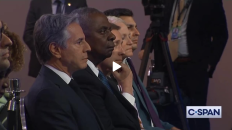The Bretton Woods system of monetary management established the rules for commercial and financial relations among the world’s major industrial states in the mid 20th century. The Bretton Woods system was the first example of a fully negotiated monetary order intended to govern monetary relations among independent nation-states.
Preparing to rebuild the international economic system as World War II was still raging, 730 delegates from all 44 Allied nations gathered at the Mount Washington Hotel in Bretton Woods, New Hampshire, United States, for the United Nations Monetary and Financial Conference. The delegates deliberated upon and signed the Bretton Woods Agreements during the first three weeks of July 1944.
Setting up a system of rules, institutions, and procedures to regulate the international monetary system, the planners at Bretton Woods established the International Monetary Fund (IMF) and the International Bank for Reconstruction and Development (IBRD), which today is part of the World Bank Group. These organizations became operational in 1945 after a sufficient number of countries had ratified the agreement.
The chief features of the Bretton Woods system were an obligation for each country to adopt a monetary policy that maintained the exchange rate by tying its currency to the U.S. dollar and the ability of the IMF to bridge temporary imbalances of payments.
On August 15, 1971, the United States unilaterally terminated convertibility of the dollar to gold. As a result, “[t]he Bretton Woods system officially ended and the dollar became fully ‘fiat currency,’ backed by nothing but the promise of the federal government.” This action, referred to as the “Nixon shock,” created the situation in which the United States dollar became the sole backing of currencies and a reserve currency for the member states. At the same time, many fixed currencies (such as GBP, for example), also became free floating.
Origins
The political basis for the Bretton Woods system was in the confluence of several key conditions: the shared experiences of the Great Depression, the concentration of power in a small number of states (further enhanced by the exclusion of a number of important nations because of the war).
Great Depression
A high level of agreement among the powerful on the goals and means of international economic management facilitated the decisions reached by the Bretton Woods Conference. Its foundation was based on a shared belief in capitalism. Although the developed countries’ governments differed in the type of capitalism they preferred for their national economies (France, for example, preferred greater planning and state intervention (dirigisme), whereas the United States favored relatively limited state intervention), all relied primarily on market mechanisms and private ownership of means of production.
Thus, it is their similarities rather than their differences that appear most striking. All the participating governments at Bretton Woods agreed that the monetary chaos of the interwar period had yielded several valuable lessons.
The experience of the Great Depression was fresh on the minds of public officials. The planners at Bretton Woods hoped to avoid a repeat of the debacle of the 1930s, when intransigent insistence by creditor nations on the repayment of Allied war debts and reparations, combined with an inclination to isolationism, led to a breakdown of the international financial system and a worldwide economic depression. The “beggar thy neighbor” policies of 1930s governments – using currency devaluations to increase the competitiveness of a country’s export products to reduce balance of payments deficits – worsened other nations’ deflationary spirals, which resulted in plummeting national incomes, shrinking demand, mass unemployment, and an overall decline in world trade. Trade in the 1930s became largely restricted to currency blocs (groups of nations that use an equivalent currency, such as the “Sterling Area” of the British Empire). These blocs retarded the international flow of capital and foreign investment opportunities. Although this strategy tended to increase government revenues in the short run, it dramatically worsened the situation in the medium and longer run.
Thus, for the international economy, planners at Bretton Woods all favored a regulated system, one that relied on a regulated market with tight controls on the value of currencies. Although they disagreed on the specific implementation of this system, all agreed on the need for tight controls.











Add comment